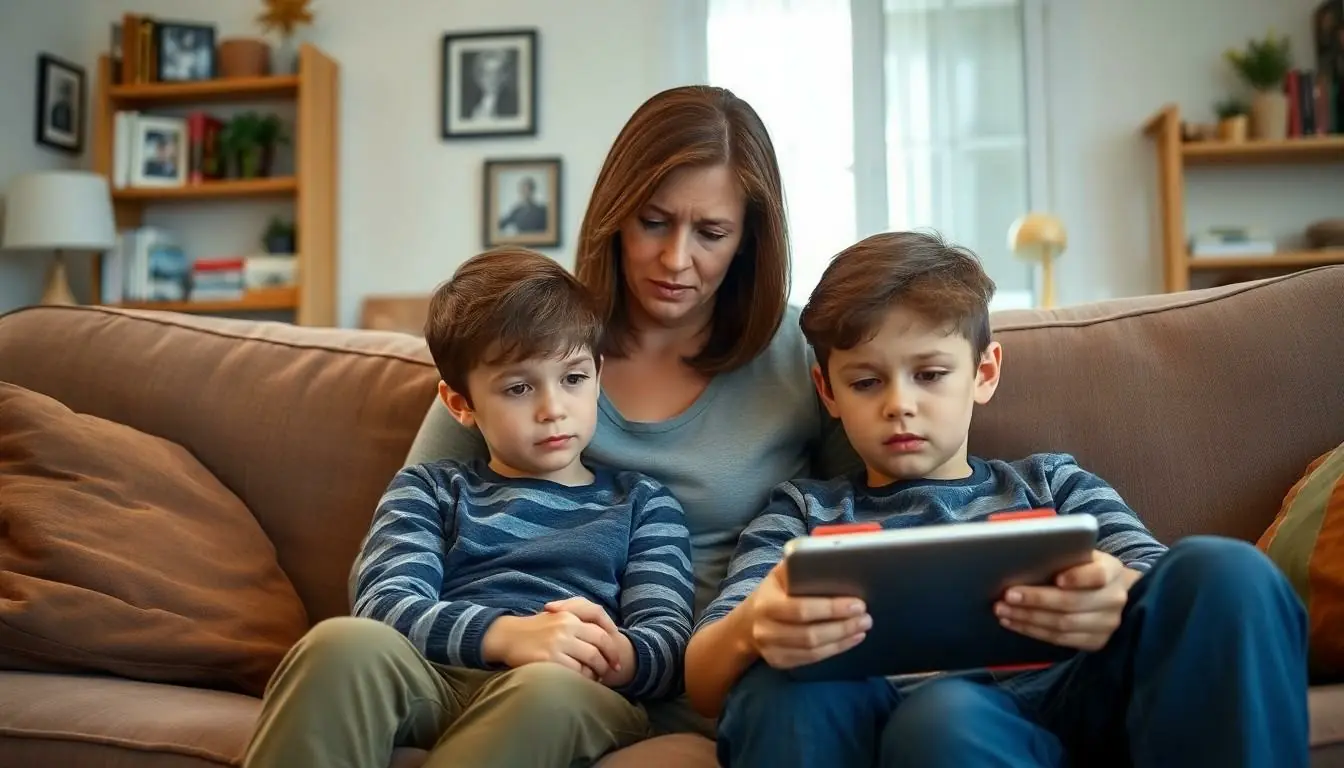Table of Contents
ToggleIn a world where screens have become the new babysitters, parents face a daunting challenge. With kids glued to tablets and TVs, it’s easy to forget that too much screen time can lead to a host of issues. From attention problems to social skills that resemble a potato, the consequences are real.
Imagine a family dinner where everyone’s engaged—except for the kid who’s busy battling virtual monsters. It’s time to reclaim those precious moments and set some boundaries. Limiting screen time isn’t just about taking away the fun; it’s about fostering healthier habits and encouraging creativity. So let’s dive into why dialing down the screen time can turn your home from a digital jungle into a vibrant, interactive playground.
Understanding Screen Time
Screen time refers to the amount of time individuals, especially children, spend engaging with screens. Managing this time effectively is crucial for fostering healthy habits and interactions.
Definition of Screen Time
Screen time includes all activities where individuals use devices with screens. This encompasses viewing content on televisions, computers, tablets, and smartphones. According to the American Academy of Pediatrics, excessive screen time can lead to issues like attention deficits and reduced physical activity. Families may find that establishing clear guidelines helps balance technology use with other engaging activities.
Different Types of Screen Time
Screen time can be categorized into several distinct types. Educational screen time involves learning tools and applications that promote skill development. Recreational screen time includes entertainment, such as movies and games, often leading to extended periods of inactivity. Social screen time focuses on interactions through social media platforms, which can impact social skills. Each type presents unique benefits and challenges, making it essential to be aware of how children interact with screens.
The Impact of Excessive Screen Time
Excessive screen time presents several challenges for children’s overall well-being. Parents must recognize the widespread effects on both physical and mental health, as well as academic performance.
Physical Health Risks
Increased screen time leads to a sedentary lifestyle. Children often engage in little physical activity, resulting in obesity and related health issues. Eye strain frequently occurs from prolonged exposure to screens, causing discomfort and potential vision problems. Moreover, sleep disturbances arise due to screen time before bed, disrupting natural sleep cycles. The American Academy of Pediatrics recommends limited screen time to prevent these health risks.
Mental Health Concerns
Excessive screen exposure correlates with increased anxiety and depression in children. Social interactions may decrease, leading to feelings of isolation. Focusing on screens over real-life connections reduces emotional intelligence and interpersonal skills. Studies indicate that excessive use can result in attention deficits, affecting concentration and learning. Setting limits on screen time can alleviate these mental health issues and foster healthier digital habits.
Academic Performance
Screen time significantly impacts academic performance. Students distracted by screens often struggle with completing assignments and maintaining focus in class. Grades may decline due to prioritizing screen use over studying. Engaging with educational content can provide some benefits, but too much recreational use leads to detrimental effects on learning. Parents should encourage balanced screen time to enhance academic outcomes and foster a love for learning.
Age Appropriateness and Screen Time Recommendations
Screen time recommendations vary significantly based on age, emphasizing the necessity of age-appropriate usage. Understanding these guidelines helps parents tailor screen time to their children’s developmental needs.
Guidelines by Age Group
The American Academy of Pediatrics offers clear screen time guidelines. For children under 18 months, avoiding screen time except for video chatting is recommended. Between ages 2 and 5, one hour of high-quality programming can be introduced. For children ages 6 and older, consistent limits on recreational screen time are essential. This allows at least 1 to 2 hours of screen time per day while prioritizing other activities. Each age group presents unique developmental stages, and parents need to adapt their approach accordingly.
Importance of Balance
Maintaining balance promotes healthier lifestyles. Combining screen activities with physical play, social interactions, and other educational pursuits enhances children’s overall well-being. Family time without screens encourages engagement and strengthens relationships. Screen time shouldn’t replace vital activities like exercise, reading, or face-to-face interactions. Instilling a harmonious balance helps foster creativity while ensuring that technology remains a tool for enrichment rather than a source of distraction. Making adjustments based on individual needs allows parents to create an environment that nurtures healthy habits.
Strategies for Limiting Screen Time
Establishing effective strategies for limiting screen time promotes healthier habits for children. Parents play a critical role in this process.
Setting Clear Boundaries
Defining specific screen time limits helps children understand expectations. Establish a daily allowance based on the American Academy of Pediatrics’ recommendations, which suggest no more than 1 to 2 hours of recreational screen time for children aged 6 and older. Create screen-free zones such as during meals or family gatherings to encourage interaction and engagement. Designate times when screens should be off, like before bedtime, to avoid sleep disturbances. Parents can use apps and tools to monitor usage effectively. Consistency in enforcing these boundaries reinforces their importance and supports children’s ability to adhere to set limits.
Encouraging Alternative Activities
Promoting activities that don’t involve screens helps diversify children’s experiences. Engage them in physical play, arts and crafts, or reading as fulfilling alternatives. Create a family schedule that includes regular outings, such as hiking or visiting local museums, to promote interaction with nature and community. Organize game nights or puzzle sessions to foster communication and teamwork among family members. Introducing hobbies, such as cooking or gardening, provides hands-on learning opportunities. Involving children in these activities encourages creativity and strengthens family bonds while naturally reducing time spent in front of screens.
Conclusion
Limiting screen time is essential for fostering healthier habits and enhancing children’s overall well-being. By setting boundaries around technology use, parents can create a more engaging environment that prioritizes family interactions and physical activities. Encouraging creativity through alternative pursuits helps children develop essential skills while reducing the risks associated with excessive screen exposure.
Establishing a balanced approach to screen time not only supports mental and physical health but also strengthens family bonds. As parents take an active role in managing their children’s screen habits, they pave the way for a more enriching and fulfilling childhood experience.








